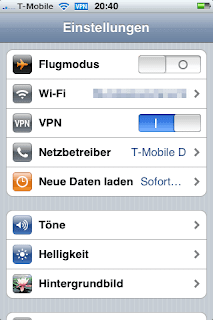
Die Profile für eduroam und VPN sind jetzt auf den entsprechenden Webseiten abrufbar:
http://www.zedat.fu-berlin.de/
http://www.zedat.fu-berlin.de/
Relevant info on AVM Fritz!Box, the NSLU2 and iPhone 3G.

 UPDATE 02.08.2008: VPN geht auch, einfach ne Mail an die ZEDAT und ihr bekommt das entsprechende Profil an eure FU-Mail-Adresse gesandt.
UPDATE 02.08.2008: VPN geht auch, einfach ne Mail an die ZEDAT und ihr bekommt das entsprechende Profil an eure FU-Mail-Adresse gesandt.
 hoch, die ihr bei der Zedat bekommt (Link auf Deutsche-Telekom.cer).
hoch, die ihr bei der Zedat bekommt (Link auf Deutsche-Telekom.cer). Dort tragt ihr als SSID eduroam ein, stellt den Security Type auf WPA/WPA2 Enterprise
Dort tragt ihr als SSID eduroam ein, stellt den Security Type auf WPA/WPA2 Enterprise ation sollte auf "PAP" eingestellt sein. Das war's schon für hier, als nächstes geht's zu Trust.
ation sollte auf "PAP" eingestellt sein. Das war's schon für hier, als nächstes geht's zu Trust.


sudo cat /dev/mtdblock* > backup.img...and store it to a safe location. With this precaution you can always switch back to a working system by putting the NSLU2 into upgrade mode and flashing the backup.img to it with upslug2.



max_peers in ~/.rtorrent.rc to 50. It was running stably with the value of 40 before."[...] focus on high performance and good code.".
Out of memory: Killed process 9754 (rtorrent).
# Hash read-ahead controls how many MB to request the kernel to read
hash_read_ahead = 5
# Interval between attempts to check the hash, in milliseconds.
hash_interval = 10
# Number of attempts to check the hash while using the mincore status,
# before forcing. Overworked systems might need lower values to get a
# decent hash checking rate.
hash_max_tries = 3
.rtorrent.rc. The trigger to avoid the kills was adjusting the peers settings. Default was a much higher number (I don't remember.. ;)). I will continue adjusting it step by step to higher values to establish what I can expect from my NSLU2.
min_peers = 1
max_peers = 40
min_peers_seed = 1
max_peers_seed = 10
max_uploads = 2
download_rate = 0
upload_rate = 50
directory = ./dl-torrents
session = ./session
# Watch a directory for new torrents, and stop those that have been
# deleted.
schedule = watch_directory,5,5,load_start=/home/torrent/torrents/*.torrent
schedule = untied_directory,5,5,stop_untied=
# Close torrents when diskspace is low.
schedule = low_diskspace,5,60,close_low_diskspace=100M
schedule = ratio,60,60,"stop_on_ratio=120,200M,150"
port_range = 30890-30998
port_random = yes
check_hash = no
use_udp_trackers = yes
# this setting remains from the actual (unstable)
# beta or alpha from rtorrent with dht tracker support.
# Thus commented out because I use a previous version
# dht_port = 30999
peer_exchange = yes
# here go the settings for faster hashing
hash_read_ahead = 5
hash_interval = 10
hash_max_tries = 3